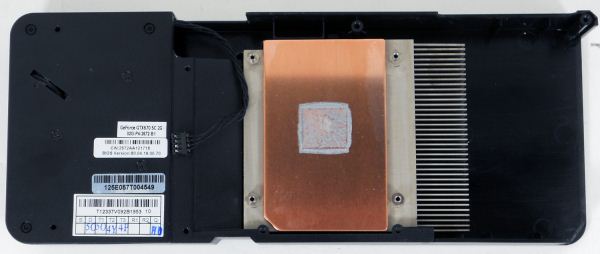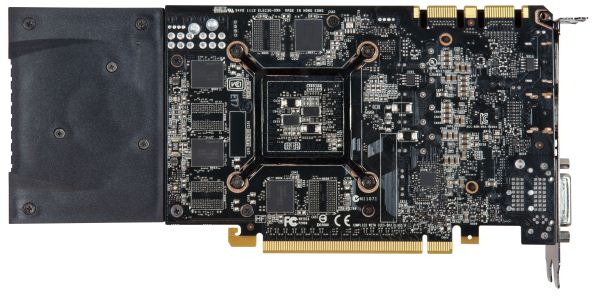NVIDIA GeForce GTX 670 Review Feat. EVGA: Bringing GK104 Down To $400
by Ryan Smith on May 10, 2012 9:00 AM ESTMeet The GeForce GTX 670
Because of the relatively low power consumption of GK104 relative to past high-end NVIDIA GPUs, NVIDIA has developed a penchant for small cards. While the GTX 680 was a rather standard 10” long, NVIDIA also managed to cram the GTX 690 into the same amount of space. Meanwhile the GTX 670 takes this to a whole new level.
We’ll start at the back as this is really where NVIDIA’s fascination with small size makes itself apparent. The complete card is 9.5” long, however the actual PCB is far shorter at only 6.75” long, 3.25” shorter than the GTX 680’s PCB. In fact it would be fair to say that rather than strapping a cooler onto a card, NVIDIA strapped a card onto a cooler. NVIDIA has certainly done short PCBs before – such as with one of the latest GTX 560 Ti designs – but never on a GTX x70 part before. But given the similarities between GK104 and GF114, this isn’t wholly surprising, if not to be expected.
In any case this odd pairing of a small PCB with a large cooler is no accident. With a TDP of only 170W NVIDIA doesn’t necessarily need a huge PCB, but because they wanted a blower for a cooler they needed a large cooler. The positioning of the GPU and various electronic components meant that the only place to put a blower fan was off of the PCB entirely, as the GK104 GPU is already fairly close to the rear of the card. Meanwhile the choice of a blower seems largely driven by the fact that this is an x70 card – NVIDIA did an excellent job with the GTX 560 Ti’s open air cooler, which was designed for the same 170W TDP, so the choice is effectively arbitrary from a technical standpoint (there’s no reason to believe $400 customers are any less likely to have a well-ventilated case than $250 buyers). Accordingly, it will be NVIDIA’s partners that will be stepping in with open air coolers of their own designs.
Starting as always at the top, as we previously mentioned the reference GTX 670 is outfitted with a 9.5” long fully shrouded blower. NVIDIA tells us that the GTX 670 uses the same fan as the GTX 680, and while they’re nearly identical in design, based on our noise tests they’re likely not identical. On that note unlike the GTX 680 the fan is no longer placed high to line up with the exhaust vent, so the GTX 670 is a bit more symmetrical in design than the GTX 680 was.

Note: We dissaembled the virtually identical EVGA card here instead
Lifting the cooler we can see that NVIDIA has gone with a fairly simple design here. The fan vents into a block-style aluminum heatsink with a copper baseplate, providing cooling for the GPU. Elsewhere we’ll see a moderately sized aluminum heatsink clamped down on top of the VRMs towards the front of the card. There is no cooling provided for the GDDR5 RAM.

Note: We dissaembled the virtually identical EVGA card here instead
As for the PCB, as we mentioned previously due to the lower TDP of the GTX 670 NVIDIA has been able to save some space. The VRM circuitry has been moved to the front of the card, leaving the GPU and the RAM towards the rear and allowing NVIDIA to simply omit a fair bit of PCB space. Of course with such small VRM circuitry the reference GTX 670 isn’t built for heavy overclocking – like the other GTX 600 cards NVIDIA isn’t even allowing overvolting on reference GTX 670 PCBs – so it will be up to partners with custom PCBs to enable that kind of functionality. Curiously only 4 of the 8 Hynix R0C GDDR5 RAM chips are on the front side of the PCB; the other 4 are on the rear. We typically only see rear-mounted RAM in cards with 16/24 chips, as 8/12 will easily fit on the same side.
Elsewhere at the top of the card we’ll find the PCIe power sockets and SLI connectors. Since NVIDIA isn’t scrambling to save space like they were with the GTX 680, the GTX 670’s PCIe power sockets are laid out in a traditional side-by-side manner. As for the SLI connectors, since this is a high-end GeForce card NVIDIA provides 2 connectors, allowing for the card to be used in 3-way SLI.
Finally at the front of the card NVIDIA is using the same I/O port configuration and bracket that we first saw with the GTX 680. This means 1 DL-DVI-D port, 1 DL-DVI-I port, 1 full size HDMI 1.4 port, and 1 full size DisplayPort 1.2. This also means the GTX 670 follows the same rules as the GTX 680 when it comes to being able to idle with multiple monitors.
















414 Comments
View All Comments
Samus - Thursday, May 10, 2012 - link
I'm just pissed I bought a GTX560 448 Core (basically a GTX570) just four months ago, and now its completely outdated lol.SlyNine - Thursday, May 10, 2012 - link
Then I'd recommend never buying videocards.On the other hand a GTX 560 may not be the newest card in its price bracket, outdated seems to be a harsh word. You still get the same performance you paid for, it's not going to drop just because something newer came out.
My 5870 was 2 1/2 years old, cost me 384$ at the time, The price/performance stayed relevant right until the 680GTX came out.
Papaspud - Thursday, May 10, 2012 - link
Exactly, I was running a GTX 285, and it didn't { slow down} when the new cards came out. Decide what card you want and be happy, the next new card is always on the way, and your card won't be the bestest forever.I was lucky and camped newegg when the GTX 680's came out and scored, very good card, but that being said AMD's cards are very nice too and I would be more than happy with one of those too, but I invested in a 3D setup so I am kind of stuck in Nvidia land for now.
As far as I can see, all of the high end cards are really nice, decide which one is for you and be happy, don't feel like you need to justify your purchase to unknown people on the internet.
will54 - Thursday, May 10, 2012 - link
Finally someone that doesn't put down one brand over the other just to justifiy his purchase. In the end these cards are plenty enough for most resolutions and games. If 3d and physx and such is something important to you go Nvidia and if Compute and zero core tech is important go AMD. The fact that both companies are strong only improves the product and price.CeriseCogburn - Friday, May 11, 2012 - link
you won't be using 7970 and 7950 for compute, those cards are thousands of dollars and have special configs and special drivers, and don't even carry the same card name, although the cores are similarhttp://www.newegg.com/Product/Product.aspx?Item=N8...
Way over 2 grand baby. That strikes down the one lie for amd, no points amd fan.
Onto the second talking point - zero core - it shows about 3 watts difference at idle, but once a person uses the card, the 7970 loses hours of advantage doing nothing in a few minutes, hence it's power bill cost will be much more anyway. That's another zero points for amd.
I'll wait till you think of something that isn't a big fat lie and trick to claim the amd cards are "good too"....
If you're going to be a good fair and peaceful person willing to bring together the forum you had better come up with something solid for amd.
We don't get to just say it's all even steven because amd loses so miserably, and then pretend it's true, while (you) spewing an outright lie and deception (firepro) and a secondary loss as a win (power).
SlyNine - Saturday, May 12, 2012 - link
There are plenty of people using consumer grade cards for compute.CeriseCogburn - Sunday, May 13, 2012 - link
Sure, plenty, plenty, plenty here never use it, and now they have one thing they can use it for with an amd card - winzip-Count your many blessings amd fan.
What a joke you people are.
There are nVidia driver hacks available BTW - whereby you can increase perf of the many released nVidia gaming cards and attempt some grand performance, but of course you guys have done that already for the past 3 generations like your opposition here, huh....
Yes, you're so well versed.
Galidou - Sunday, May 13, 2012 - link
And here comes the fanboy to break the dream of neutrality, we will never be alone. We just said we were happy that someone commented about whatever brand people buy, as long as you are happy with your purchase.''Perception is what matters, someone who buys a honda civic can be as happy as someone who buys a Ferrari, sure the feeling of driving it will be different. But in the end, it's the perception towards life that matters.
CeriseCogburn - Sunday, May 13, 2012 - link
Someone who had to buy Nvidia for the 3D, since amd sucks so badly at it, owned nVidia (285) prior, and thus, essentially has zero amd experience.Yes, be happy, ignorance is bliss, in even the face of epic fail (no amd 3D use worth crap).
I mean is that what you want, someone kissing your inner feeling child so the lie you live can remain ?
It seems so.
CeriseCogburn - Friday, May 11, 2012 - link
I see SlyNine.... so the jump from your 5870 to the next tier, the 6970 was crap, and then to 7970 was crap, only becoming relevant when the 680GTX hit:" My 5870 was 2 1/2 years old, cost me 384$ at the time, The price/performance stayed relevant right until the 680GTX came out. "
So according to you, the last 2 amd flagship releases even combined were not of sufficient jump percentage...
I guess that's another giant mark in the destruction of the recently popularized complaint about this release "being the smallest jump we've ever seen".